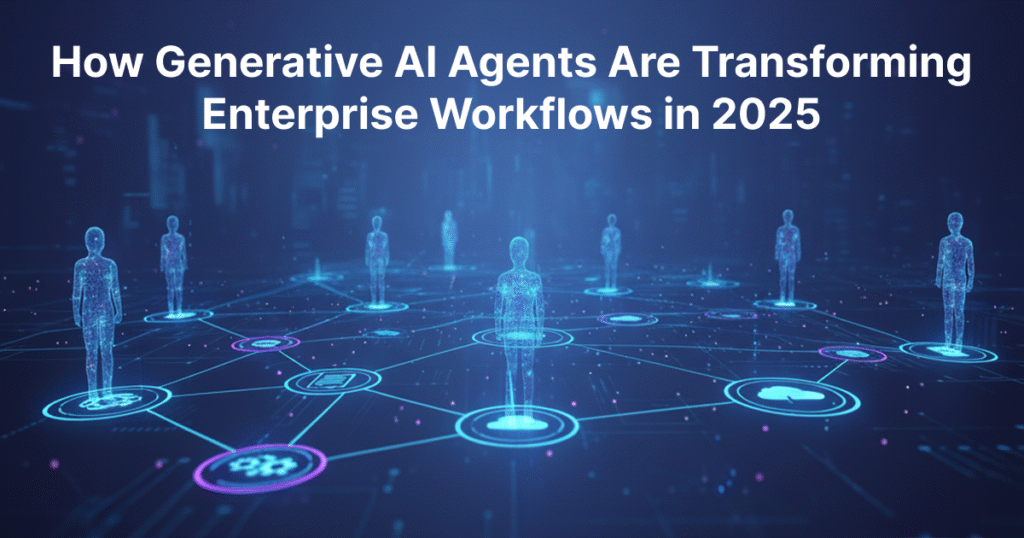2025 is proving to be the year when Generative AI Agents stop being experiments and start becoming essential to enterprise operations. Unlike the chatbots or rule-based automation tools of the past, these AI-powered agents don’t just respond to instructions — they plan, reason, and act with context. They understand goals, interact with business systems, and coordinate tasks across teams and tools.
For enterprises, this shift means moving beyond small efficiency gains to a complete rethinking of how work gets done.

What Makes Generative AI Agents Different?
Traditional automation was rigid. Processes had to be mapped step by step, leaving little room for flexibility. Generative AI Agents, by contrast, are adaptive and context-aware. They can work with both structured data from systems like ERP or CRM, and unstructured data such as emails, documents, or logs.
Think of an agent that manages expense approvals. It can scan receipts, validate vendor details, check company policy, and schedule reimbursements — all without a human touching the workflow unless an exception arises. Or picture an IT support agent that monitors tickets, suggests fixes, and only escalates complex issues. This isn’t just assistance; it’s AI Workflow Automation that takes ownership of an entire process chain.
How They’re Reshaping Enterprise Workflows
The impact of Enterprise AI Agents is being felt across industries, with changes showing up in four key areas:
Speed and Efficiency
Agents slash processing times for routine tasks like claims, reimbursements, and ticket triage. By handling repetitive work, they free up employees to focus on higher-value activities.
Integration Across Systems
Agents can bridge silos by connecting CRMs, ERPs, and knowledge bases. Instead of employees shuffling between tools, agents deliver seamless workflows across the stack.
Proactive Operations
Unlike older tools that only react, AI-powered agents anticipate. They flag risks before they become compliance issues, identify supply chain bottlenecks before they cause delays, and surface insights for managers in real time.
Human Augmentation
The role of employees is shifting from “doing the process” to “guiding the process.” With agents taking care of transactions, humans can dedicate time to judgment, creativity, and strategic decision-making.
What Makes This Possible
Behind the scenes, a few breakthroughs are powering the rise of Generative AI Agents:
Agent-ready data and APIs: Enterprises are building cleaner data pipelines and APIs that allow agents to interact dynamically with core systems.
Multi-agent orchestration: Specialized agents — one for retrieval, one for reasoning, one for compliance — now work together in coordinated fashion.
Governance and guardrails: With greater autonomy comes greater responsibility. Enterprises are putting in place oversight frameworks that ensure security, compliance, and trust.
Tooling maturity: Platforms now offer memory, monitoring, and orchestration capabilities that let companies deploy agents at scale with confidence.
Benefits and Challenges
The opportunities are clear: faster operations, fewer errors, proactive workflows, and more time for human creativity. But challenges remain:
Trust and Accuracy: Agents can still misinterpret context or generate incorrect results, making human oversight essential.
Security and Compliance: As agents gain more autonomy, safeguarding sensitive data becomes paramount.
Cost and Scalability: Running multiple agents simultaneously can be expensive; organizations must balance speed, accuracy, and cost.
Cultural Shifts: Employees need to learn how to collaborate with digital coworkers and adapt to new workflows.
Looking Ahead
2025 is only the beginning. Over the next year, expect to see:
Mature ecosystems where multiple agents work together seamlessly across departments.
Wider adoption of AI Workflow Automation in mission-critical processes, not just support functions.
Multimodal agents that understand not just text, but also images, voice, and sensor data.
Stronger governance frameworks to ensure transparency and accountability.
In this near future, Enterprise AI Agents won’t be viewed as optional tools. They will become digital teammates that every organization relies on to stay competitive.
Conclusion
The rise of Generative AI Agents signals a fundamental shift in enterprise workflows. They’re faster, smarter, and more capable of integrating across systems than anything that came before. The organizations that thrive will be those that invest early in data readiness, governance, and human-agent collaboration.
For enterprises willing to embrace this new model, AI-powered agents won’t just automate work — they’ll redefine it.
Search
Categories

Author
-
Chidambara Ganapathy is a backend developer who enjoys turning ideas into seamless solutions with Python and Django. With over 6 years in IT—including the last 2.5 years focused on backend development—he bridges the gap between client conversations and clean, efficient code. These days, he’s into vibe coding—using AI-powered tools like ChatGPT and Gemini—while exploring the frontiers of Generative AI and DevOps. Off work, he’s a singer, music lover, and cricket/automobile enthusiast.
